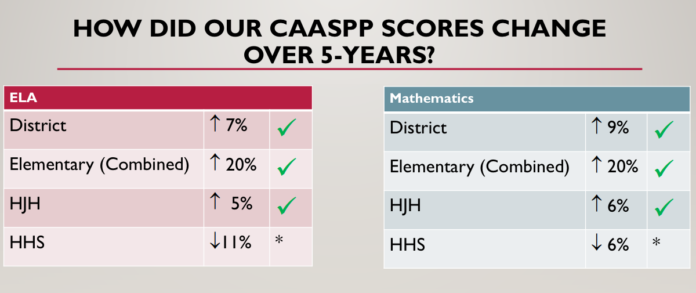The 2019 California Assessment of Student Performance and Progress (CAASPP) results are in for the Healdsburg Unified School District and there are several areas of progress to celebrate, including major gains in growth at the elementary level and growth in math.
The CAASPP is the state’s annual measure of student’s performance and progress in English Language Arts (ELA) and math, and is an indicator for how well schools did in these areas in a given year. The tests also provides students, teachers and parents with an update on student’s academic performance.
Students in grades 3 to 8 and 11th-graders are tested in the spring.
During the Nov. 20 Healdsburg Unified School District Board of Trustees meeting, the district’s director of curriculum and instruction, Erin Fender, presented the board with the results and shared a few
key takeaways.
In a nutshell, areas of success include: seeing a five-year growth in nearly all areas, seeing major gains at the elementary level, seeing growth for Hispanic students in math and ELA, seeing math in the district ranked 14 among 102 similar California school districts and having 81 fewer students score a level 1 (low) in math in 2019 than in 2015. Also in ELA, 69 fewer students scored at level 1 in 2019 than in 2015.
Areas of improvement include: increased 11th-grade participation rates and scores, ELA improvement for socioeconomically disadvantaged students and increased focused interventions for eighth-graders struggling with ELA and math.
Results
In the last five years overall district ELA scores have increased by 7% and 9% in math. At the elementary level, the ELA and math score increased by 20%.
Fender noted that this gain was impressive.
“It’s remarkable data at the elementary school, beyond the norm,” she said.
However, the numbers look a bit rough at secondary schools.
ELA scores at the junior high level increased by 5%, and by 6% for math. Although ELA and math scores at the high school level saw a decrease — 11% in ELA, and 6% in math.
Fender said the district is trying to make sense of why there is such slow growth at the high school level.
She noted that there is a discrepancy in performance at the 11th-grade level. According to Fender, 11th-grade students who may often score high on AP tests can sometimes show low scores in the CAASPP.
Fender said this might be because the test isn’t as “important” to 11th-graders as other tests like the SAT/ACT, so they may not take the CAASPP as seriously.
However, math for the district overall, is a bright spot.
“Over the past five years we are going in the right direction,” Fender said of overall district scores.
She added that district scores in math are not too far off from the state and similar school districts.
“We have amazing growth here at the elementary,” Fender said.
According to the data, math scores at Healdsburg Elementary School increased by 38% and by 63% at the Healdsburg Charter School.
English Learners
English Learners (EL) and Reclassified Fluent English Proficient (RFEP) students also saw a good increase in their scores over the past five years. ELA scores for these groups increased by 3%. At the county level ELA scores for EL’s and RFEP students only increased by 2%.
Math scores for EL and RFEP students also saw nice growth in math, increasing their scores by 7%.
“We are leading here in a lot of places,” Fender said.
Trustee Aracely Romo-Flores congratulated the overall positive trajectory of the scores.
“It is encouraging seeing this,” School Board President Jami Kiff said. She added that the district should work on explaining the importance of the CAASPP to 11th-graders to try to elicit better participation.








